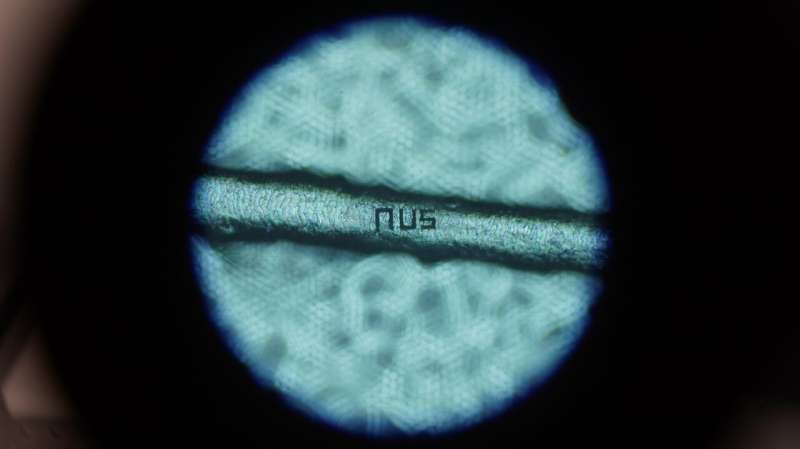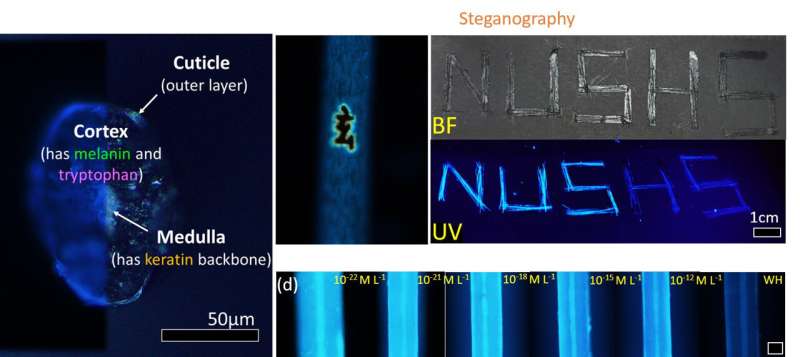Physicists use hair fluorescence to repurpose human hair waste

Physicists from the National University of Singapore (NUS) have developed an innovative method of converting human hair waste into a functional material that can be used to encrypt sensitive information or detect environmental pollutants.
On average, a single person can shed anywhere from 50 to 100 strands of hair per day. This contributes to a sizeable amount of waste which may take years to decompose into its natural form, or end up in incinerators, waste streams and dumps which produces toxic fumes including ammonia and sulfur dioxide during the decomposition process. Landfills of hair waste can leach toxic chemicals into bodies of water, harming marine wildlife and potentially lead to algal blooms. Furthermore, human hair can be breeding grounds for pathogens, putting nearby communities at risk of disease outbreaks.
“As the human population increases, there will be increasing pressure to manage human hair waste,” said Professor Sow Chorng-Haur from the Department of Physics under the NUS Faculty of Science. “Instead of sending hair waste to the incinerator or landfill, it is worthwhile to repurpose hair waste for other potential applications.”
In line with NUS’ commitment to integrated sustainability solutions, Prof Sow and his research team comprising Dr. Sharon Lim from NUS, Dr. Zhang Zheng from the Agency of Science, Technology and Research, and Malcolm Sow from NUS High School of Math and Science, devised a simple, heat-based and chemical-free method to transform human hair waste into a functional material for potential steganographic and pollutant detection applications. The team reported their findings in the journal Advanced Photonics Research which was published with a cover feature in late 2022.

Repurposing hair waste using heat
Under UV light, human hair has been shown to exude a mild blue fluorescence. While the chemical composition of the hair is likely to play a role, the exact causes or mechanisms underpinning this glow have yet to be determined. Leveraging the fluorescent nature of human hair, the researchers sought to transform hair waste into functional material.
In their first experiment, the researchers used a focused laser beam to engrave tiny patterns on the surface of a single strand of black human hair. Under a fluorescence microscope and UV light, the researchers found that these patterns glowed intensely. Compared with the rest of the strand, the laser-engraved patterns glowed around 350% to 400% brighter.
Apart from using a focused laser beam, the process can be upscaled for industrial application through established, readily available industrial heating processes so that hair can be treated in larger quantities. As a proof of concept, the researchers placed entire strands of hair on small ceramic dishes, which were then heated at 300°C to 400°C on top of a hot plate for three minutes. Similar to the laser experiment, heat-treated hair glowed much brighter under a fluorescence microscope relative to pristine strands. In particular, hair strands that are heated to 360°C fluoresced nearly thrice as intensely as untreated hair.
“The discovery of making human hair glow through a simple heating process is a surprise finding in the laboratory. Through thorough investigation, we found that the breaking down of keratin and tryptophan, proteins which form hair, into small chemical by-products during heating was one of the major contributing factors to making the hair glow brighter,” said Prof Sow.
Concealing secrets and catching chemical spills
The results indicate that lasers can be used for steganography which is the practice of concealing secret information within an ordinary message or object to avoid detection. In particular, the researchers found that they could tune their focused laser beam such that it caused no physical damage to the hair strand, but could still successfully etch a fluorescent pattern onto it. The end-product was a seemingly pristine strand that would reveal its secrets when put under UV light.
On a more macroscopic scale, the study suggested that heat-treated hair could be used to detect toxic spills. The researchers found that under the same heating conditions, white hair exhibits greater enhancement to fluorescence compared to black hair.
Advantageously, the white hair is sensitive to a substance called methylene blue, a dye chemical commonly used in the textile industry and is routinely dumped as harmful waste in bodies of water. In the presence of methylene blue, the heat-treated white hair glows brightly under UV light, making it a potentially inexpensive tool to detect methylene blue pollution.
Prof Sow and his team are currently working on developing human hair waste as a steganographic ink and portable detector for the presence of methylene blue suitable for industrial use.
“For example, by breaking down heated pristine hair, and suspending them in separate bottles for inkjet printing, hidden messages can readily be printed on different surfaces, thus making this unique waste material an alternative sustainable steganographic material,” said Prof Sow.
More information:
Malcolm Miao Geng Sow et al, Microstyling of Biofluorescence in Human Hair as Sustainable and Functional Waste, Advanced Photonics Research (2022). DOI: 10.1002/adpr.202200161
Citation:
Physicists use hair fluorescence to repurpose human hair waste (2023, June 30)
retrieved 30 June 2023
from https://phys.org/news/2023-06-physicists-hair-fluorescence-repurpose-human.html
This document is subject to copyright. Apart from any fair dealing for the purpose of private study or research, no
part may be reproduced without the written permission. The content is provided for information purposes only.
For all the latest Science News Click Here
For the latest news and updates, follow us on Google News.

